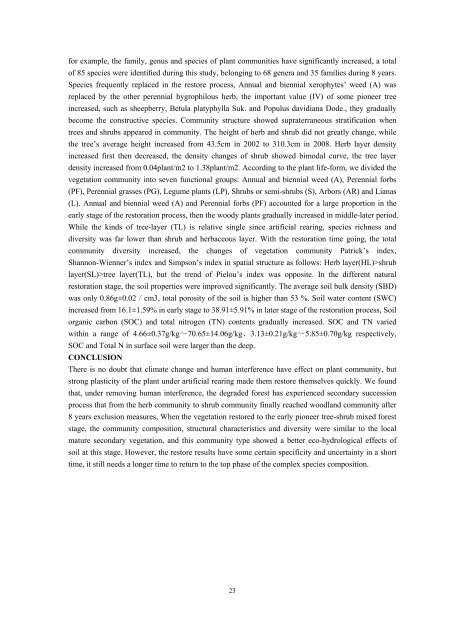Climate Change and Dryland Agricultural Ecosystem Management
Climate Change and Dryland Agricultural Ecosystem Management
Climate Change and Dryland Agricultural Ecosystem Management
Create successful ePaper yourself
Turn your PDF publications into a flip-book with our unique Google optimized e-Paper software.
for example, the family, genus <strong>and</strong> species of plant communities have significantly increased, a total<br />
of 85 species were identified during this study, belonging to 68 genera <strong>and</strong> 35 families during 8 years.<br />
Species frequently replaced in the restore process, Annual <strong>and</strong> biennial xerophytes’ weed (A) was<br />
replaced by the other perennial hygrophilous herb, the important value (IV) of some pioneer tree<br />
increased, such as sheepberry, Betula platyphylla Suk. <strong>and</strong> Populus davidiana Dode., they gradually<br />
become the constructive species. Community structure showed supraterraneous stratification when<br />
trees <strong>and</strong> shrubs appeared in community. The height of herb <strong>and</strong> shrub did not greatly change, while<br />
the tree’s average height increased from 43.5cm in 2002 to 310.3cm in 2008. Herb layer density<br />
increased first then decreased, the density changes of shrub showed bimodal curve, the tree layer<br />
density increased from 0.04plant/m2 to 1.38plant/m2. According to the plant life-form, we divided the<br />
vegetation community into seven functional groups: Annual <strong>and</strong> biennial weed (A), Perennial forbs<br />
(PF), Perennial grasses (PG), Legume plants (LP), Shrubs or semi-shrubs (S), Arbors (AR) <strong>and</strong> Lianas<br />
(L). Annual <strong>and</strong> biennial weed (A) <strong>and</strong> Perennial forbs (PF) accounted for a large proportion in the<br />
early stage of the restoration process, then the woody plants gradually increased in middle-later period.<br />
While the kinds of tree-layer (TL) is relative single since artificial rearing, species richness <strong>and</strong><br />
diversity was far lower than shrub <strong>and</strong> herbaceous layer. With the restoration time going, the total<br />
community diversity increased, the changes of vegetation community Patrick’s index,<br />
Shannon-Wienner’s index <strong>and</strong> Simpson’s index in spatial structure as follows: Herb layer(HL)>shrub<br />
layer(SL)>tree layer(TL), but the trend of Pielou’s index was opposite. In the different natural<br />
restoration stage, the soil properties were improved significantly. The average soil bulk density (SBD)<br />
was only 0.86g±0.02/cm3, total porosity of the soil is higher than 53 %. Soil water content (SWC)<br />
increased from 16.1±1.59% in early stage to 38.91±5.91% in later stage of the restoration process, Soil<br />
organic carbon (SOC) <strong>and</strong> total nitrogen (TN) contents gradually increased. SOC <strong>and</strong> TN varied<br />
within a range of 4.66±0.37g/kg~70.65±14.06g/kg、3.13±0.21g/kg~5.85±0.70g/kg respectively,<br />
SOC <strong>and</strong> Total N in surface soil were larger than the deep.<br />
CONCLUSION<br />
There is no doubt that climate change <strong>and</strong> human interference have effect on plant community, but<br />
strong plasticity of the plant under artificial rearing made them restore themselves quickly. We found<br />
that, under removing human interference, the degraded forest has experienced secondary succession<br />
process that from the herb community to shrub community finally reached woodl<strong>and</strong> community after<br />
8 years exclusion measures, When the vegetation restored to the early pioneer tree-shrub mixed forest<br />
stage, the community composition, structural characteristics <strong>and</strong> diversity were similar to the local<br />
mature secondary vegetation, <strong>and</strong> this community type showed a better eco-hydrological effects of<br />
soil at this stage. However, the restore results have some certain specificity <strong>and</strong> uncertainty in a short<br />
time, it still needs a longer time to return to the top phase of the complex species composition.<br />
23












